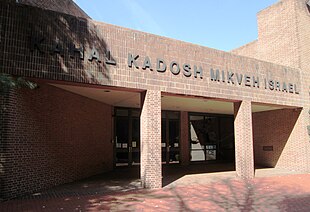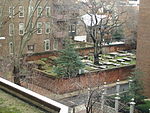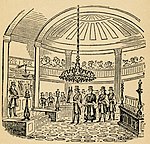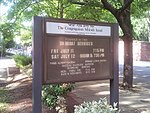Congregation Mikveh Israel
| Kahal Kadosh Mikveh Israel | |
|---|---|
Hebrew: קהל קדוש מקוה ישראל | |
 Mikveh Israel in 2013 | |
| Religion | |
| Affiliation | Orthodox Judaism |
| Rite | Sephardic Spanish and Portuguese |
| Ecclesiastical or organizational status | Synagogue |
| Leadership |
|
| Status | Active |
| Location | |
| Location | 44 North Fourth Street, Philadelphia, Pennsylvania |
| Country | United States |
Location in Philadelphia | |
| Geographic coordinates | 39°56′57″N 75°08′51″W / 39.949224°N 75.14750°W |
| Architecture | |
| Date established | 1773 (as a chartered congregation) |
| Completed |
|
| Website | |
| mikvehisrael | |
Congregation Mikveh Israel (Hebrew: קהל קדוש מקוה ישראל, lit. 'Holy Community Hope of Israel'), is a Sephardic Orthodox Jewish synagogue located at 44 North Fourth Street in Philadelphia, Pennsylvania, in the United States. The congregation traces its history from 1740.[1] Mikveh Israel is a Spanish and Portuguese congregation that follows the rite of the Amsterdam esnoga. It is the oldest synagogue in Philadelphia, and the longest running in the United States.
The congregation moved to its current building at 44 North Fourth Street in 1976. The synagogue is located within Philadelphia's Old City Historic District and adjacent to Independence Mall. Mikveh Israel is an active community synagogue with services on the Sabbath, holy days, and special occasions. It offers adult education and cultural programming with a focus on the Spanish and Portuguese tradition and history. It is active within the Center City Jewish community and its kitchen is under the kosher supervision of the Community Kashrus of Greater Philadelphia The Keystone K.
Rabbi Albert Gabbai has led the congregation since 1988. Rabbi Yosef Zarnighian has served as Assistant Rabbi since September 2021.[2]
Burial ground and founding, 1740–1782
[edit]
Nathan Levy was a Jewish merchant in Philadelphia when one of his children died in 1738. Desiring a dedicated place for burial, he applied to John Penn, Pennsylvania's colonial proprietor, for "a small piece of ground" with permission to make it a family cemetery. This property was at the corner of 9th and Walnut Streets, the present site of the Walnut Street Theatre.
Congregation Mikveh Israel traces its history to September 25, 1740 when the Province of Pennsylvania and Thomas Penn authorized the burial ground at the north-west corner of Spruce Street and South Darien Street (between 8th and 9th Streets) meant to be a permanent burial ground for the entire Jewish community of Philadelphia. Levy was buried there upon his death in 1753. This burial ground became the Mikveh Israel Cemetery.[3]
Jews in Philadelphia in the 1740s and 1750s organized themselves informally for services. In 1761 they acquired a Torah scroll and met in a private residence on Sterling Alley, then between Cherry and Race Streets and Third and Fourth Streets.[4] The congregation moved to a rented building on Cherry Street and held their first Sabbath services on July 25, 1771. The group chartered itself as an organization in 1773.[5]
It is estimated that in 1775, the city of Philadelphia had a population of approximately 35,000 of whom 300 were Jewish.[6] Mikveh Israel counted among its members revolutionary patriots including Jonas Phillips, the Gratz family, and Haym Solomon who financed the war.
Gershom Mendes Seixas (1745-1816) was minister of Congregation Shearith Israel in Manhattan when the British occupied New York City during the Revolutionary War in 1776. Seixas closed the synagogue and left the city rather than align with the British. He moved first to Connecticut and then to Philadelphia where he led Mikveh Israel.
Third and Cherry Streets, 1782–1825
[edit]
Mikveh Israel built its first synagogue in 1782 at Third and Cherry Streets. Its initial location was moved after protest that its proposed site next to a church would offend the Dutch Reform Protestant congregants. Prominent Philadelphians including Benjamin Franklin and Robert Morris contributed to its building fund[7] along with local merchant and synagogue member Ephraim Hart who would later organize the Board of Stock-Brokers.[8]
In September 1782, the congregation dedicated the new building on Cherry Street near Third Street. The building seated 200 persons and had accommodations for the clergy adjoining it.[9] At the dedication, Seixas invoked heaven's blessing upon "the members of these states in Congress assembled and on His Excellency George Washington, commander general of these Colonies."[10]
Manuel Josephson (1729–1796) had also come to Mikveh Israel from New York in 1776. Josephson petitioned the synagogue board to build a mikveh in 1784 and by 1786 it was open under Johnson's organization.[11]
Seixas returned to New York in 1784 and Mikveh Israel invited his replacement at Shearith Israel, Jacob Raphael Cohen (1738-1811) to Philadelphia in Seixas' place. Cohen served at Mikveh Israel from 1784 until his death in September 1811. Cohen was replaced in 1814 by Emanuel Nunes Carvalho (1771-1817) who had emigrated from Britain to Barbados to Charleston, South Carolina before being called to Mikveh Israel. Carvalho published A Key to the Hebrew Tongue (Philadelphia, 1815) and his A Sermon, preached on Sunday, July 7, 1816, on Occasion of the Death of the Rev. Mr. Gershom Mendes Seixas (Philadelphia, 1816) became the first Jewish sermon printed in the United States. Cohen served until his death in 1817.[12] Abraham Israel Keys (1780-1828) served as minister from 1824 to 1828.
Third and Cherry Streets, 1825–1860
[edit]
The congregation laid the cornerstone for its second building on September 26, 1822 at the same Cherry Street location.[13] William Strickland designed the Egyptian Revival synagogue, the first of its kind in the United States.[14][15] A contemporary account reads that "the galleries are semi-circular, extending around the north and south of the building, and are supported by the columns which extend to the dome." The new building was dedicated on January 21, 1825.
In 1829, Isaac Leeser (1806–1868) became the synagogue's leader and held that position until 1850. Leeser was one of a small number of rabbis who defended orthodox practices against the growth of Reform Judaism in the mid-nineteenth century United States.[16]
Mikveh Israel established its second cemetery in 1849 in South Philadelphia in what was then outside the city's southern limits. The second Mikveh Israel Cemetery (11th and Federal) is located at 1114 Federal Street and now known as the Federal Street Burial Grounds and Mikveh Israel Cemetery #2.[17] A Pennsylvania Historic marker was added in March 2009.[18]
Sabato Morais (1823–1897) succeeded Leeser as Mikveh Israel's minister in 1851.
117 N Seventh Street, 1860–1909
[edit]
The Cherry Street synagogue was replaced in 1860 by a building at 117 North 7th Street designed by architect John McArthur Jr. who would later design Philadelphia City Hall.[19]
Sabato Morais served as minister at Mikveh Israel for forty-six years from 1851 to 1897. He was an opponent of slavery prior to the Civil War and encouraged the creation of the Ladies' Hebrew Association for the Relief of Sick and Wounded Union Soldiers in May 1863.[20] Morais admired Abraham Lincoln and authored a sermon and prayer on the death of Lincoln's son Willie Lincoln in 1862; delivered a public sermon four days after Lincoln's death in April 1865; and delivered another public sermon on June 1, 1865, the national day of mourning. Later in June 1865, Morais sent a donation of $300 collected from Mikveh Israel members for the construction of the Lincoln Memorial.[21]
Morais' son Henry Samuel Morais taught in the synagogue's Hebrew school program, was a principal founder of the Jewish Exponent newspaper in 1887, and served as acting minister of the congregation from his father's death in 1897 through 1898.[22]
Kahal Kadosh Beth El Emeth had been founded in 1857 as a pulpit for Rev. Leeser following Leeser's departure from Mikveh Israel. Beth-El-Emeth dedicated a cemetery at 55th and Market Streets in 1857. Beth El Emeth dissolved in 1897 and many of its members joined Mikveh Israel. Mikveh Israel took possession of the cemetery and continues to administer it in the present day.
Mikveh Israel was a center of Jewish education in America during this time. The first U.S. Jewish teachers' college, Gratz College, established under the provisions of the will of Hyman Gratz (1776-1857), began in 1897. Mikveh Israel members started Dropsie College, the first post-graduate institution for Jewish learning in the world in 1907, bringing Cyrus Adler to Philadelphia.
Leon Haim Elmaleh (1873–1972) came to Mikveh Israel as religious leader in 1898 and served until 1929 when he became Reverend Emeritus until his death. Elmaleh was a founder of the Philadelphia Board of Rabbis and the Levantine Jews Society of Philadelphia.[23]
2321 N Broad Street, 1909–1976
[edit]
Pilcher and Tachau designed the fourth building which Mikveh Israel constructed in 1909 at Broad and York Streets. The block until 1894 had been the site of Forepaugh Park where Adam Forepaugh presented circuses and spectacles, and where the Philadelphia Athletics played in 1890 and 1891. It was developed in the late 1890s with residential homes, and Mikveh Israel and Dropsie College built their complex in the late 1900s following the Jewish population up North Broad Street.
During WWI, the Mikveh Israel Association applied for a Red Cross Auxiliary in the Southeastern Pennsylvania Chapter in May 1917. Leading women of the congregation established a work room in the adjoining Gratz College building where one day a week they made surgical garments and collected supplies.[24]
Dr. Abraham A. Neuman (1890–1970) was rabbi from 1927 to 1943.[25] Dr. Neuman was succeeded by David Jessurun Cardozo (1896-1972).[26] Reverend Alan D. Corre (1931-2017) came to Philadelphia from Manchester, England at age 24 in 1955[27] and served as rabbi until 1963.[28]
Noam Chomsky (born 1928) grew up in Philadelphia at Mikveh Israel on North Broad Street where his father, Dr. William Chomsky (1896-1977), ran the Hebrew school, was president of Gratz College, and taught at Dropsie College.[29]
Rabbi Ezekiel Musleah (1927-2020) joined Mikveh Israel as minister in 1964 and served in this role until 1979.[30]
Dropsie College remained at the Broad and York complex following Mikveh Israel's departure. A 1981 fire damaged part of Dropsie College's building and the school eventually relocated to Temple Adath Israel in Merion in 1984. The complex was sold to a church, which did little to rehabilitate the fire-damaged building. The organization Food for Life purchased the complex in November 1992 for $275,000 from the church.[31]
The 2321 N Broad Street building was sold for $825,000 in 2015, and was open to the public as a retail clothing store in 2017.[32]
44 N Fourth Street, 1976–present
[edit]
The creation of Independence National Historical Park was authorized in 1948 and established in 1956. The Jewish population along N Broad Street contracted in the years after World War II. The planned redevelopment of the blocks near Independence Hall and the congregation's original locations encouraged Mikveh Israel to return to the city's historic area.
Members had pledged $250,000 by spring 1961 and Christ Church donated $1,000 to the building fund to support and welcome the synagogue's return. Mikveh Israel initially considered locations at 8th and Spruce Streets, 5th and Locust Streets, and near the Christ Church burial ground.[33] Later that year the synagogue had selected the site behind the burial ground, north of Market Street and south of Arch Street.[34] Dr. Bernard J. Alpers, vice-president of the synagogue, persuaded his friend the Philadelphia architect Louis Kahn to plan the new synagogue building. Kahn produced ten designs for the building between 1961 and 1972.[35] The Congregation decided that construction and maintenance costs would be too high and did not build Kahn's designs.
The new building was instead designed by the architectural firm Harbeson, Hough, Livingston & Larson[36] on a more modest scale, and shared with the nascent National Museum of American Jewish History. The fifth building was dedicated and opened on July 4, 1976 [37][38]
Rabbi Joshua Toledano (1944–2013) came to Mikveh Israel as minister in the early 1980s, and served until 1988 when he left to start the Mekor Baruch Center in Lower Merion.[39] Rabbi Allan Lazaroff began to serve as minister in September 1989.[40]
Rabbi Albert E. Gabbai has served as congregation minister since 1988; Rabbi Gabbai grew up in Cairo[41] and was educated at Yeshiva University in New York and the Shehebar Sephardic Center in Jerusalem.[42] Charles Garson of Gibraltar served as Hazzan[43] from 2010 through 2014, and returns periodically for Jewish festivals and holidays.[44]

Mikveh Israel is an active synagogue with 200 families and is a member of the Center City Kehilla[45] and regularly hosts Sephardic heritage cultural and educational events. The synagogue hosted the 2017 annual world conference of the Society for Crypto-Judaic Studies.[46]
Mikveh Israel and Christ Church have a long-standing relationship dating from the founding of the synagogue to the present day. The present location of Mikveh Israel places the two congregations as close neighbors. Christ Church was supportive of Mikveh Israel's first plan to construct a building in the 18th-century. When Mikveh Israel's synagogue burned in 1872, Christ Church contributed funds to the construction of the new building. The congregations have a long-standing custom of sharing a fellowship-dinner once a year which alternates between the buildings of the two congregations.[47]
Mikveh Israel is the site of the US memorial for Israel's Lieutenant Colonel Yonatan Netanyahu who was killed in the 1976 Operation Entebbe which rescued 102 of 108 hostages. Netanyahu had attended the Philadelphia area Cheltenham High School with brother Benjamin Netanyahu. Mikveh Israel was selected as the site of the United States memorial, constructed of granite and marble. Benjamin Netanyahu attended the 1986 dedication of the memorial as Deputy Ambassador to the United States and visited again in 2016 to mark the fortieth anniversary of his brother's death.[48]
The National Museum of American Jewish History moved to its own building on the southeast corner of 5th and Market Streets on November 15, 2010.[49]
Uriah P. Levy (1792–1862), who would be the first Jewish Commodore in the United States Navy, grew up in Philadelphia and celebrated his bar mitzvah at Mikveh Israel in 1807. A statue of Levy was commissioned by two Jewish U.S. Navy captains and dedicated at the 44 N Fourth Street site in 2011.[50]
Members
[edit]- Lucy Marks, African American Jew
See also
[edit]- American Jews
- History of the Jews in the United States
- History of the Jews in Pennsylvania
- List of the oldest synagogues in the United States
References
[edit]- ^ Sarna, Jonathan (2004). American Judaism. New Haven, Connecticut: Yale University Press. p. 19. ISBN 9780300101973.
- ^ Safran, Jarred (September 28, 2022). "You Should Know… Rabbi Yosef Zarnighian of Mikveh Israel in Old City". Jewish Exponent. Philadelphia Jewish Exponent. Retrieved September 28, 2022.
- ^ "Documents and Drinks: The Jewish Collections at HSP". hsp.org. Historical Society of Pennsylvania. April 14, 2015. Retrieved March 25, 2019.
- ^ Dubin, Murray (1996). South Philadelphia: Mummers, Memories, and the Melrose Diner. Temple University Press. p. 143. ISBN 1-56639-429-5. Retrieved May 15, 2009.
mikveh israel.
- ^ Olitsky, Kerry M. (1996). The American Synagogue: A Historical Dictionary and Sourcebook. Greenwood Publishing Group. ISBN 9780313288562. Retrieved November 18, 2013.
- ^ Hirschfeld, Fritz (2005). George Washington and the Jews. Published by University of Delaware Press. p. 50. ISBN 0-87413-927-9. Retrieved May 15, 2009.
- ^ Lee, Hannah (October 12, 2011). "An Odyssey From Amsterdam to Philadelphia". Philadelphia Jewish Voice. Archived from the original on January 18, 2012. Retrieved October 24, 2011.
- ^ Singer, Saul Jay (February 6, 2019). "Ephraim Hart And The Founding Of The Stock Exchange". jewishpress.com. The Jewish Press. Retrieved April 22, 2019.
- ^ Markens, Isaac (1888). The Hebrews in America: A Series of Historical and Biographical Sketches. New York: Isaac Markens. p. 63. Retrieved June 1, 2009.
Mickve Israel philadelphia.
- ^ Shapiro, Gary (February 17, 2017). "Columbia Trustee, Jewish Leader and Patriot of the American Revolution". Columbia News. New York, New York: Office of Communications and Public Affairs. Retrieved March 24, 2019.
- ^ Levine, Yitzchok (June 7, 2013). "Glimpses Into American Jewish History: Manuel Josephson, Orthodox American Patriot" (PDF). The Jewish Press. Retrieved March 25, 2019.
- ^ Olitzky, Kerry M. (1996). The American Synagogue: A Historical Dictionary and Sourcebook. Greenwood Publishing Group. p. 312. ISBN 0313288569.
- ^ "The Jews are building a new synagogue at Philadelphia". Niles' Weekly Register. Baltimore, Maryland. January 4, 1823.
- ^ Diana Muir Appelbaum, "Jewish Identity and Egyptian Revival Architecture", Journal of Jewish Identities, 2012 (5(2) p. 7.
- ^ "Thomas U. Walter's Crown Street Synagogue, 1848–49", by Rachel Wischnitzer, The Journal of the Society of Architectural Historians, Vol. 13, No. 4 (December 1954), pp. 29-31
- ^ Sherman, Moshe D. "A Short History of Orthodox Judaism in America". myjewishlearning.com. My Jewish Learning. Retrieved March 24, 2019.
Reprinted from the American Jewish Historical Society's American Jewish Desk Reference: The Ultimate One-Volume Reference to the Jewish Experience in America, published by Random House.
- ^ "Federal Street Burial Ground, a.k.a. Mikveh Israel Cemetery #2 - Philadelphia, Pennsylvania". 13 August 2018.
- ^ http://files.usgwarchives.net/pa/philadelphia/cemeteries/mikvehisrael-federal.txt [bare URL plain text file]
- ^ Congregation Mikveh Israel. "Our History." 2011. Accessed February 2, 2015. http://www.mikvehisrael.org/e2_cms_display.php?p=past_our_history Archived 2018-06-15 at the Wayback Machine
- ^ Marcus, Jacob Rader (1981). The American Jewish Woman: A Documentary History. New York, New York: KTAV Publishing House, Inc. p. 243. ISBN 0870687522.
- ^ "Rabbi Sabato Morais Sends His Synagogue's Contribution to the Lincoln Monument". shapell.org. Shapell Manuscript Foundation. Retrieved March 25, 2019.
- ^ Adler, Cyrus; Dobsevage, I. George (1901–1906). "Morais, Henry Samuel". In Isidore Singer (ed.). The Jewish Encyclopedia. New York: Funk & Wagnalls.
- ^ "Congregation Mikveh Israel records, 1765-2011". Philadelphia Area Archives Research Portal. Retrieved 29 March 2019.
- ^ Philadelphia in the World War 1914-1919. New York, New York: Wynkoop Hallenbeck Crawford Co. 1922. p. 638.
mikveh israel broad street philadelphia.
- ^ "Dr. Abraham A. Neuman, Jewish Historian, Dies". The New York Times. November 21, 1970. p. 33.
- ^ "Rabbi Cardozo Dies; A Sephardic Leader". The New York Times. September 5, 1972. p. 40.
- ^ "Names in the News". Jewish Post. Indianapolis. July 8, 1955. p. 18. Retrieved March 25, 2019.
- ^ Sarna, Jonathan D. (December 2, 2017). "Passing of Professor Alan Corré". H-Judaic. Michigan State University Department of History. Retrieved March 25, 2019.
- ^ Samuels, David (12 November 2010). "Q&A: Noam Chomsky". tabletmag.com. Tablet Magazine. Retrieved March 24, 2019.
- ^ Elkin, Jay (July 22, 2020). "Rabbi Ezekiel Nissim Musleah, Chair of Beit Din and Leader at Mikveh Israel, Dies at 92". Jewish Exponent. Philadelphia. Retrieved April 28, 2021.
- ^ Avery, Ron (July 28, 1993). "More than just a shelter; beautiful buildings utilized". Daily News. Philadelphia.
- ^ "Official Unlimited is officially one of the sweetest stores in town". Naked Philly. Philadelphia, Pennsylvania.
- ^ "Christ Church Gives Mikveh Israel $1,000 For Synagogue Fund". Philadelphia Inquirer. Philadelphia, Pennsylvania. May 30, 1961. p. 19.
- ^ "Synagogue Moves Philadelphia Site". The New York Times. New York, New York. November 12, 1961. Retrieved June 1, 2009.
- ^ There is a drawing of the proposed building in the New York Museum of Modern Art, and a reproduction of this drawing in Encyclopaedia Judaica, volume 10, column 691. Kahn's form concept for the synagogue is quoted in Encyclopaedia Judaica, volume 15, column 624.
- ^ "American Database by Architect". www.isjm.org. Archived from the original on 2 February 2017. Retrieved 23 November 2016.
- ^ Shenker, Israel (July 19, 1976). "Jewish Museum Opening Has a Colonial Theme". The New York Times. Retrieved June 1, 2009.
- ^ "Our History". www.mikvehisrael.org. Archived from the original on 15 June 2018. Retrieved 23 November 2016.
- ^ Michaels, D (March 7, 2013). "Sephardic Rabbi Joshua Toledano, Dies at the Age of 69". Jewish Exponent. Philadelphia, Pennsylvania. Retrieved March 25, 2019.
- ^ Avery, Ron. "Synagogue marks 250 years in city roots go to Spanish diaspora". Daily News. Philadelphia, Pennsylvania. p. 06.
- ^ Zighelboim, Selah Maya (October 3, 2018). "Albert Algazi, Rabbi Albert Gabbai Shed Light on Mideast Jewry". Jewish Exponent. Philadelphia. Retrieved March 24, 2019.
- ^ "Albert Gabbai". ssc.org.il. Shehebar Sephardic Center. Retrieved March 25, 2019.
- ^ Elkin, Michael (January 21, 2013). "Live Music, and So Much More, This Sunday Afternoon". Jewish Exponent. Philadelphia, Pennsylvania. Retrieved December 23, 2017.
- ^ Gotlieb, Andy. "Celebrate the Holiday of Pessah 5779 at Congregation Mikveh Israel". Jewish Exponent. Retrieved April 22, 2019.
we are pleased to welcome Rev. Charles Garson who will be joining Rabbi Albert Gabbai in conducting the service. Garson comes back to us from London and will be assisting in services throughout the holiday.
- ^ "Participating Organizations". centercityjews.org. Center City Kehillah. Retrieved December 23, 2017.
Congregation Mikveh Israel
- ^ Feinstein, Skip (December 20, 2017). "On contact with Orthodoxy". Jewish News. Phoenix, Arizona. Retrieved December 23, 2017.
- ^ "Catholics Opening First Bible Week; Daily Scriptural Readings to Be Instituted -- Approval of Popes, Is Recalled". The New York Times. February 9, 1952. p. 14. Retrieved October 27, 2009.
- ^ Hoffman, Gil (July 4, 2016). "Yoni Netanyahu's Childhood friends plan Entebbe event in Philadelphia". The Jerusalem Post. Retrieved March 24, 2019.
- ^ "Biden among notables attending opening ceremony of National Museum of American Jewish History". philly.com. Philadelphia, Pennsylvania. November 15, 2010.
- ^ Singer, Saul Jay (February 7, 2018). "The Mutiny Against Captain Uriah P. Levy". The Jewish Press. Retrieved March 24, 2019.
Further reading
[edit]- Sabato Morais (1892). "Mickve Israel Congregation of Philadelphia". Publications of the American Jewish Historical Society (1): 13–24.
- Marvin D. Schwartz (1976). The Role of the Jew in the Forging of the Nation: the Inaugural Exhibition of the Museum of American Jewish History, Philadelphia. Philadelphia: Museum of American Jewish History.
- Jordan Stranger-Ross (2006). "Neither Fight Nor Flight: Urban Synagogues in Postwar Philadelphia". Journal of Urban History. 32 (6). doi:10.1177/0096144205284400. S2CID 143004126.
- Susan G. Solomon (2009). Louis I. Kahn's Jewish Architecture: Mikveh Israel and the Midcentury American Synagogue. UPNE.
External links
[edit]- Official website
- Mikveh Israel History
- Digitized historical documents from Congregation Mikveh Israel at the Philadelphia Congregations project
- Temple University Libraries: Hebrew Sunday School Society of Philadelphia (Pa.) Records: Series 5, 6, and 7
- Penn Libraries: Sabato Morais Papers
- Yeshiva University Libraries: Guide to the Henry S. Morais Papers 1877-1930
- Geni: Projects-Presidents of Congregation Mikveh Israel, Philadelphia
- Dutch-American culture in Pennsylvania
- Dutch-Jewish culture in the United States
- Jews and Judaism in Philadelphia
- Synagogues in Philadelphia
- Portuguese-Jewish culture in the United States
- Sephardi Jewish culture in Pennsylvania
- Spanish-American culture in Pennsylvania
- 20th-century synagogues in the United States
- Sephardi synagogues
- 1740 establishments in Pennsylvania
- Old City, Philadelphia
- Orthodox synagogues in Pennsylvania
- Synagogues completed in 1976
- Synagogues completed in 1909
- Synagogues completed in 1860
- Synagogues completed in 1825
- Synagogues completed in 1782
- Jewish organizations established in 1773
- Synagogues in Pennsylvania

